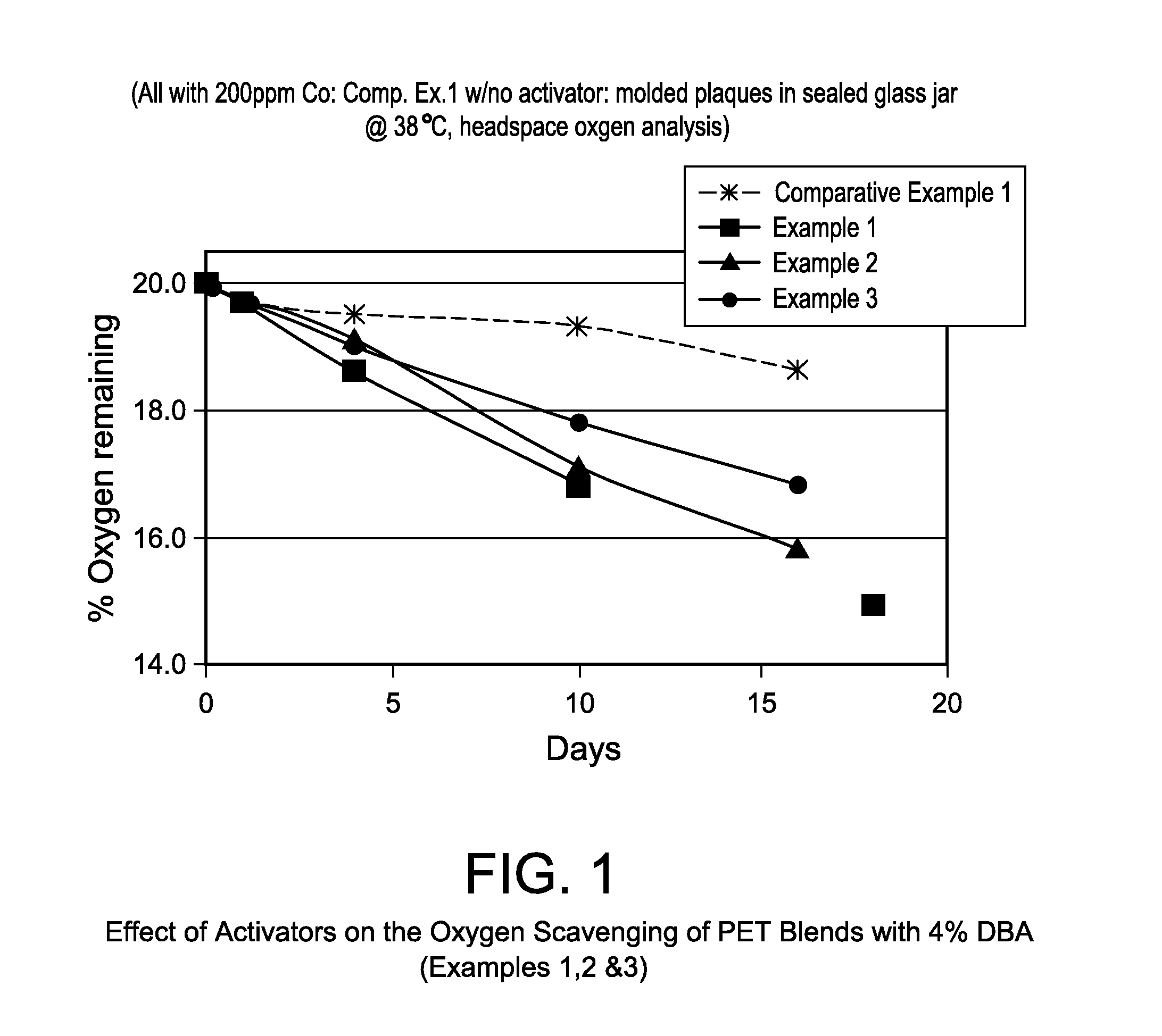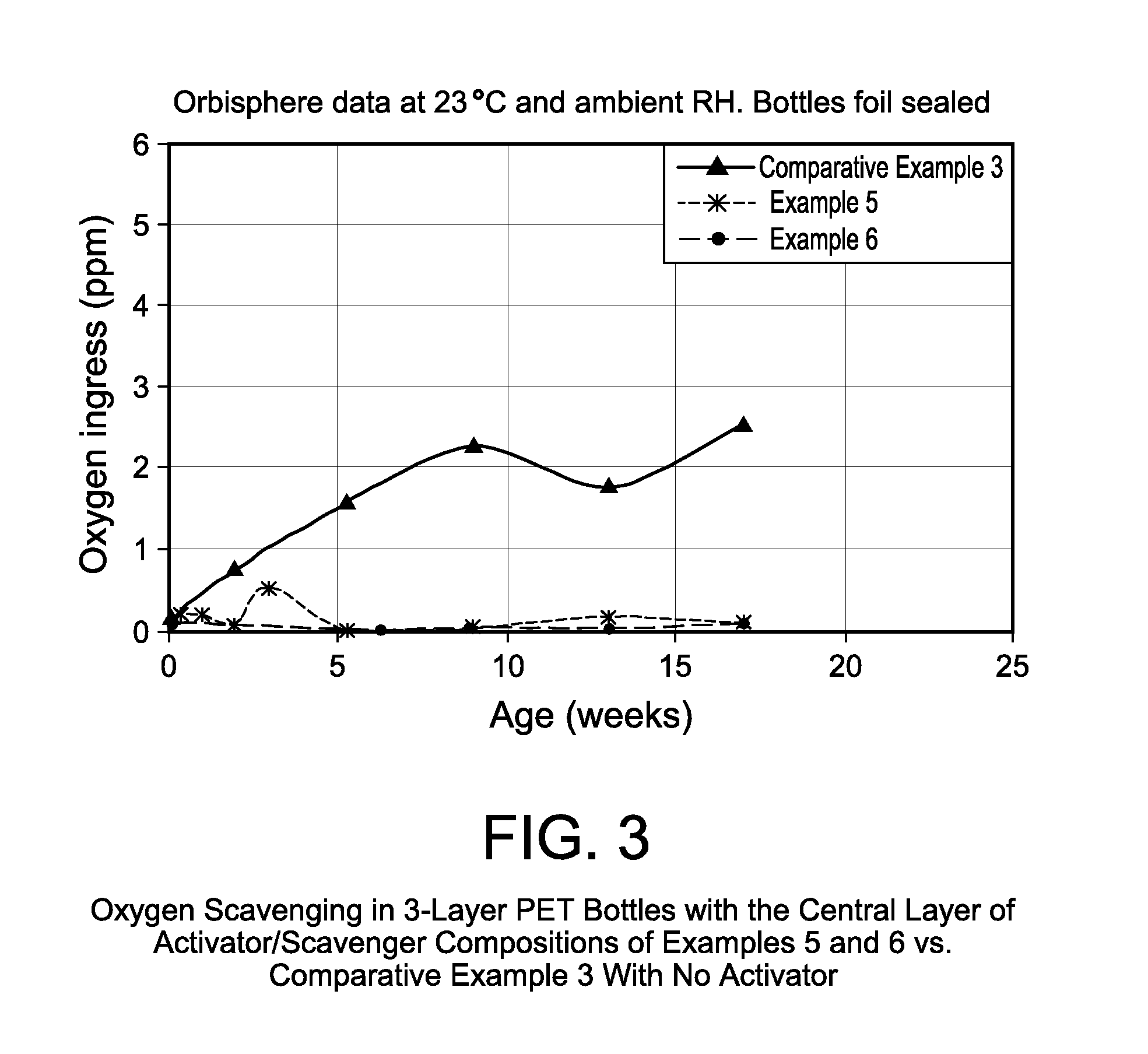Activated oxygen scavenging compositions for plastic containers
- Summary
- Abstract
- Description
- Claims
- Application Information
AI Technical Summary
Benefits of technology
Problems solved by technology
Method used
Image
Examples
example 1
[0143]94.9 parts by weight of dry, bottle grade (0.82 I.V.) PET pellets (Heatwave™ CF746, Eastman Chemical Co., USA), were tumble blended with 4 parts of dibenzyl adipamide (abbreviated as “DBA”) (obtained from Wilshire Technologies, Princeton, N.J., USA), 1 part of a polyester ionomer—Eastman AQ™ 55S grade polymer (Eastman Chemical Co, Kingsport, Tenn.) and 1000 ppm of cobalt neodecanoate powder. The blended mixture was directly injection molded into rectangular plaques on an Arburg Model 320-210-500 injection molding machine at a melt temperature of 265° C. and a mold temperature of 10° C. and a cycle time of 40 sec. The rectangular plaques were 15.9 cm long by 4.4 cm wide, having five equal sections with increasing stepped thicknesses of 2 mm, 1.8 mm, 2.5 mm, 3.3 mm and 4 mm.
example 2
[0147]94.9 parts by weight of dry, PET pellets (Heatwave™ CF746) were tumble blended with 4 parts of dibenzyl adipamide, 1 part of a polyether diester namely, PEG400 di-2-ethyl hexanoate (TegMeR® 809 from Hallstar Co., Chicago, Ill., USA) and 1000 ppm of cobalt neodecanoate powder. The blended mixture was directly injection molded into rectangular plaques and the plaques were tested for oxygen scavenging as described in Example 1 and Comparative Example 1. The oxygen scavenging data as shown in FIG. 1, indicates substantial increase in the rate (i.e., activation) of the oxygen scavenging compared to the comparative example 1 which did not contain the polyether diester as an activator.
example 3
[0148]94.9 parts by weight of dry, PET pellets (Heatwave™ CF746) were tumble blended with 4 parts of dibenzyl adipamide, 0.3 parts of N-Hydroxyphthalimide (“NHPI”) (from Sigma-Aldrich, Milwaukee, Wis., USA) and 1000 ppm of cobalt neodecanoate powder. The blended mixture was directly injection molded into rectangular plaques and the plaques were tested for oxygen scavenging as described in Example 1 and Comparative Example 1. The oxygen scavenging data as shown in FIG. 1, indicates substantial increase or activation of the oxygen scavenging compared to the Comparative Example 1 with no NHPI as an activator.
PUM
| Property | Measurement | Unit |
|---|---|---|
| Fraction | aaaaa | aaaaa |
| Fraction | aaaaa | aaaaa |
| Percent by mass | aaaaa | aaaaa |
Abstract
Description
Claims
Application Information
 Login to View More
Login to View More - R&D
- Intellectual Property
- Life Sciences
- Materials
- Tech Scout
- Unparalleled Data Quality
- Higher Quality Content
- 60% Fewer Hallucinations
Browse by: Latest US Patents, China's latest patents, Technical Efficacy Thesaurus, Application Domain, Technology Topic, Popular Technical Reports.
© 2025 PatSnap. All rights reserved.Legal|Privacy policy|Modern Slavery Act Transparency Statement|Sitemap|About US| Contact US: help@patsnap.com



